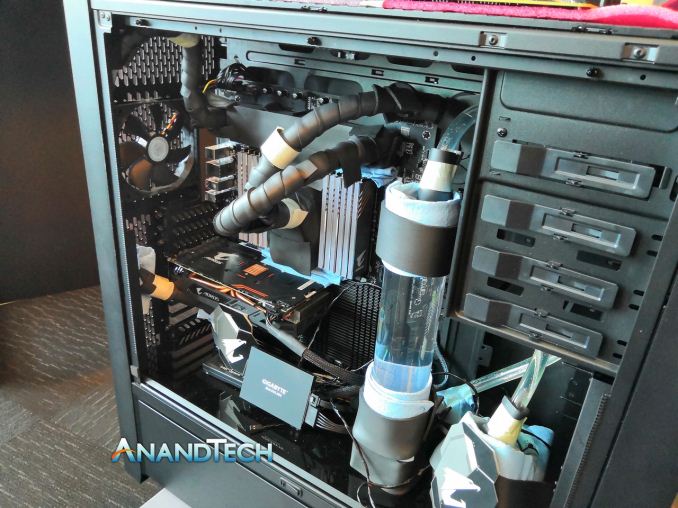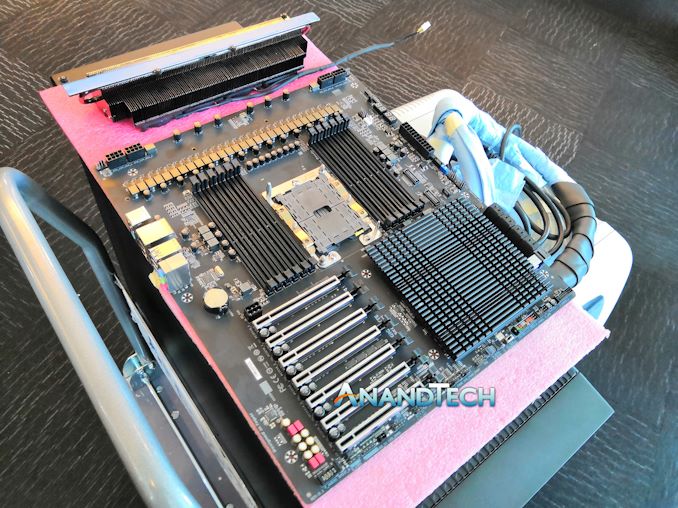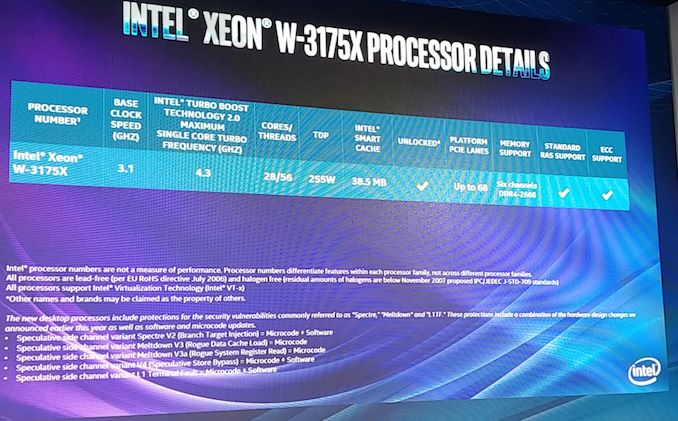The Price of Intel’s Unlocked 28-Core Xeon W-3175X: OEM Tells us ‘around $8k’
by Ian Cutress on January 6, 2019 7:25 PM EST
In perhaps a very unexpected turn of events, one of our first meetings at CES has heralded an important nugget of information. One of the boutique system integrators here at CES has told me, in conjunction with a system they are planning to ship, that Intel’s 28-core W-3175X processor will be ‘around $8k’ at retail.
In the middle of 2018, Intel announced that it would be releasing an unlocked 28-core processor, which we subsequently learned will be the Xeon W-3175X, which will have a TDP of 255W with frequencies from 3.1 GHz base to 4.3 GHz single core. It would require a new motherboard due to the six memory channels and a socket change.
We were also told that Intel is planning both 28-core and 24-core parts, and we should expect systems with the top chip and corresponding motherboards (such as ASUS’ ROG Dominus Extreme, or GIGABYTE's un-named board) to easily be in the five figure range, especially as systems with the hardware will also be paired with high-end graphics, lots of memory, and plenty of storage.
We were told by the system builder that they will expect to start shipping systems sometime in Q2, however the processors will be available before then.
If the price of $8k holds true, the chip is expensive. More reasonable estimates at the announcement were nearer $4k, because of what the CPU has to compete against. Ultimately, Intel knows that this chip will end up competing against its own Xeon Platinum 28-core parts, which already start from $8874. Because this will be a single socket part, unlocked, and have all the cores, I can totally see it eating into some of Intel’s margin of those parts. This hardware is perfect for high frequency traders who make 6 or 7 figures a day on the market – they will happily drop 5 figures on a faster machine if it means they can make more money. These chips aren’t for 99.99% of consumers at the end of the day, and I can very easily see Intel making the argument that they’re not competing against 32-core Threadripper.
We’re looking to confirm this price with other vendors, if it's with/without tax or what a boutique builder might charge to add it into the system. We know that some online retailers have starting listing parts at just over $4000, so it's an interesting disparity between the two. But we thought you should know what we’ve been told. Thoughts below!
*Images from this story were taken at Computex 2018 and Intel's August 2018 event.
Addition:
We have spoken to other people in the know, and have learned that Intel's original pricing for the chip was around $8000. One of our sources is saying that the initial documents put the price up at that high, however discussions with distributors have confirmed that the on-shelf price is more likely to be around $4500, in line with some retailer listings already out on the market. However, Intel's documents to its partners still state the $8000 price; perhaps the MSRP is that high, however retailers might be cutting into their own margins to sell the chip.












27 Comments
View All Comments
rquared - Sunday, January 6, 2019 - link
I doubt it. Even the 18 Core Intel® Xeon® W-2195 has a MSRP of$2553.00. Why would a 28 Core cost 3 times as much? A MSRP of $4000 for the 28 Core sounds realistic to me.
ZoZo - Sunday, January 6, 2019 - link
8-core Core i7-9800X officially costs $599.Yet the 18-core Core i9-9980xe that operates on the same platform costs $1999 and not $1348 as it should if it were proportionately priced to the i7-9800X.
Higher end means higher premium.
GreenReaper - Sunday, January 6, 2019 - link
You've got a higher base clock speed (which I think all cores are guaranteed to maintain). Based on that you're talking 41.4Ghz-cores vs 86.8 - over double the raw power. You get it in one socket, albeit at almost twice the TDP. And in theory you can go even higher...I imagine the workloads might be quite specialized, though! And because of that, potentially less volume, which again increases the price a bit.
KOneJ - Wednesday, January 9, 2019 - link
It would eat into their 8176 and 8180 sales, especially since those require 2s+. I servers need 1s compute without the lanes, pricing this low would cannibalize that niche. They're not aiming this at consumers and they're sacrificing a premium XCC die, so they're not going to sell it for 4k when they could sell it as an 8176 or 8180 for 8k. Just sayin' TM.twtech - Thursday, January 10, 2019 - link
So you're saying you would buy one of these @ $8k?I'm curious what your workload is, that is specifically 1S only.
At $4-5k, I would have pushed to have this CPU added to our workstation spec at work. At $8k, even if we wanted to spend that kind of money, I don't think it would win out vs. comparably-priced systems with 2 regular, non-W Xeons.
HurleyBird - Sunday, January 6, 2019 - link
Good luck with that, IntelMikewind Dale - Sunday, January 6, 2019 - link
"and I can very easily see Intel making the argument that they’re not competing against 32-core Threadripper"Let's get us some benchmarks!
Kevin G - Sunday, January 6, 2019 - link
Intel's prior press event was to align these chips up against the coming 32 core Threadrippers. With a price of $8000, Intel is flirting with what AMD could price their 32 core, high clocked Zen 2 based Epyc chips with a full 512 bit wide memory interface. *If* Zen 2 lives up to the promised IPC increases and clocks a notch higher than Zen+, AMD could be dethroning this chip in pretty much every metric that matters: core count, stock clock speeds, memory channel count, PCIe lane count, maximum socket support and cost. And that ignores the potentially of AMD serving other niche markets with higher clocked/lower core parts or higher cores per socket offerings (up to 64 cores).The one advantage that Intel can leverage are the in-package options they offer: FPGA and higher performance fabric (Omnipath). From the picture in the article, the CPU socket supports the chips that have additional fabric, which is a nice touch.
Cascade Lake cannot come soon enough for Intel. With the delay of this part into 2019, it would not surprise me if the W3175X changed from Sky Lake-SP to Cascade Lake to leverage some process improvements for higher clocks.
One thing of the matters its that there are already single socket LGA 3647 motherboards in the server space: they just don't support a 255W unlocked CPU. I'm also torn seeing 2 DIMM per channel layouts with this chip. If anything, the platform would be focused on higher memory clocks with tighter timings which takes a hit when the second DIMM is placed into a system. Capacity is offset by supporting 8-rank, registered ECC DIMMs across six slots for those who want it alongside the unlocked CPU. Those that need really insane memory capacity are better off jumping to a dual/quad socket with 2 DIMM per channel configurations. Even the existing single socket boards are split between one and two DIMM per channel offerings based upon target performance and density.
twtech - Wednesday, January 9, 2019 - link
AMD isn't going to charge that much. Neither does Intel really, for that matter. The W3175x - as a single-processor-only high-clocked 28 core CPU - would have made sense as a workstation chip around $4,000.People who buy their $10,000 28-core server variant CPUs do so because they want maximum performance in servers that will fit in an ordinary rack. They buy a 4-socket server from Dell or HP, and get 108 cores, 216 threads, in a machine that will easily fit into their existing server rack.
If that's your workload/mindset, you can make a case for those $10k CPUs. What you can't make a case for is a single-socket-only 28-core CPU for $8k. If you have that kind of money to burn on workstation CPUs, you'll probably buy a machine with a pair of 24 core Xeons for a similar price instead.
Or, if it's about single-core performance rather than number of cores, then you wouldn't' have been looking at the W3175x anyway - a 9900K or whatever its Xeon equivalent is would have been a better fit for your needs.
I think this was a phantom product, never really intended to be something anyone would actually buy, intended to slow AMD down. Ironically, it may have had the opposite effect. People who would have gone ahead and bought systems with a pair of $2k Intel 18-core CPUs may have waited to see if the W3175x would be better. Now, with W3175x having turned out to be a marketing stunt, maybe if you can afford to wait a couple months' longer before replacing your last-gen machines, you can get something with Epyc 2 in it.
DanNeely - Sunday, January 6, 2019 - link
at this price the chilled water cooler Intel demoed it with @5ghz suddenly doesn't seem so unreasonable.